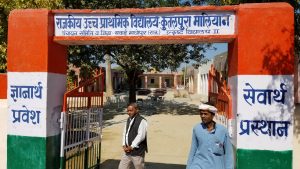How can I describe my trip to India? Words can’t possibly capture the overload on my senses, the warmth and curiosity of the people, the richness of the culture and traditions, the perplexity about the way systems work (or don’t), and the feelings evoked by all this and more. Let me focus on what I learned about schools and sex education in the part of India where I visited.
Wendy L. Sellers
Education in Indian Primary and Middle Schools

India has made a concerted effort to have one public school in every village. In 2005, the Right to Education Bill was enacted, requiring students to attend school until age 14. The public schools are staffed by qualified teachers and principals who earn a decent salary and a pension. Public schools are funded with money from the Center (India’s central government) and each state. However, the public views anything free as being less valuable, so many families try to pay to send their children to private schools. The private schools are more likely to teach English, which is viewed to be essential to a child’s future success.
I visited a public school in a small village in a rural part of northern India, near Ranthambore National Park in Rajasthan.[1] The sign on the archway above the school entrance says: “Enter to Learn. Leave to Serve.” The principal of the school, Mr. Pratab Maharana, recruited students by going door to door to talk to parents. As a result, the attendance grew from 80 to 180 students, ranging range in age from 6 to 14 years old. Parents began to trust the school and liked their students to receive milk in the morning and lunch at noon. The lunch is prepared by local women, providing them with a livelihood.
Indian schools in rural areas face many challenges. The rural schools are not funded adequately, so they don’t have chairs and desks for their students. On the day of my school visit, new tables and chairs were delivered. They were purchased by the Grand Circle Foundation set up by the travel company with which I was touring. The electricity goes off all day in rural areas and is redirected to the urban areas. Therefore, the rural schools usually only have electricity one or two hours a day. Even so, Mr. Maharana expressed the need for funding for a library and computer lab for his students.
Sex Education in Indian Schools

Sex education is not taught in most Indian schools. Even though the standardized curriculum includes health and physical education as a requirement, the emphasis is on physical activity and health check-ups. In fact, the “National Curriculum Framework 2005” acknowledges:
There is growing realisation that the health needs of adolescents, particularly their reproductive and sexual health needs, require to be addressed. Since these needs predominantly relate to sex and sexuality, which is culturally a very sensitive area, they are deprived of opportunities to get the appropriate information. As such, their understanding of sexuality and reproductive health and their behaviour in this regard are guided predominantly by myths and misconceptions, making them vulnerable to risky situations, such as drug/substance abuse and HIV/ AIDS transmission. Age- appropriate context-specific interventions focused on adolescent reproductive and sexual health concerns, including HIV/AIDS and drug/ substance abuse, therefore, are needed to provide children opportunities to construct knowledge and acquire life skills, so that they cope with concerns related to the process of growing up.[2]
Despite this realization, the topics of puberty and sex education are not addressed. As a result of ignorance, young people are ill-equipped to make healthy sexual choices and form healthy relationships. This results in girls missing school once they begin menstruating, strict gender stereotypes, child marriages, LGBTQ discrimination, and sexual assaults.
What Is Being Done Now
The Indian government has been taking actions to improve hygienic conditions and social norms involving girls and women. One big effort involves providing hygienic systems in each village in the form of clean water and a public bathroom. Another is the initiative of installing bathrooms inside each rural home. Another national social campaign is designed to improve the value of girls and prevent female foeticide and infanticide. The campaign slogan, “Save a Girl Child,” appears on signs all over the country, including in front of the school entrance. Due to the “Save a Girl Child” campaign, schools are seeing more female students than male students in recent times.
I met several people who are trying to change the lack of comprehensive sex education programming and other harmful realities through networking and nongovernmental agency initiatives. An initiative that has received worldwide attention is The Pad Project, focused on making sanitary pads available. Their documentary short, “Period. End of Sentence.” won an Academy Award in March 2019. It documents a women-led initiative to make and disseminate sanitary pads in rural areas of northern India. Their slogan is “A period should end a sentence, not a girl’s education.”
Looking Toward the Future
With all this in mind, I am more determined than ever to explore the connections made on my trip to India to increase puberty education among Indian schools and other community organizations. It will also be important to continue to find resources for sex education that Indian teachers lack, particularly in rural areas. I am having conversations with several contacts, and I welcome any ideas for ways to advance this goal. Please contact me with your suggestions.
The 2021 edition of Puberty: The Wonder Years for grades 4, 5, and 6 is now available as a digital curriculum.
Get your free sample lesson now!
[1] Wendy’s school visit photo album
Updated 2021-10-1



